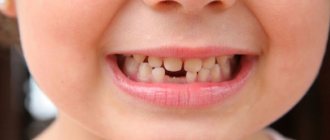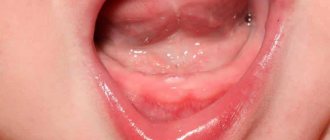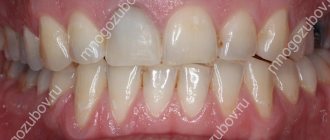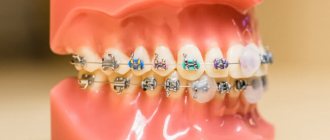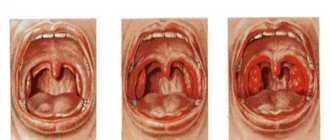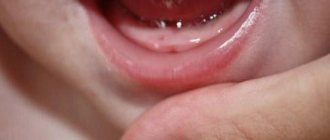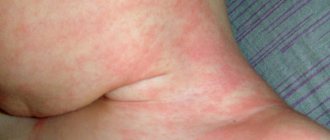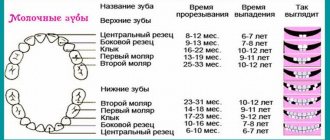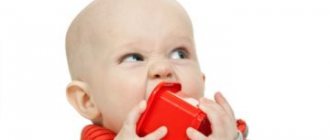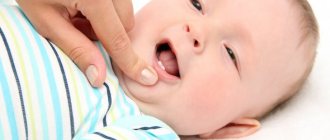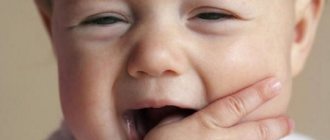Timing of teething in children
The process of dentition (teething) occurs individually for each baby. However, there are deadlines within which each new tooth must appear. We have compiled information about the timing of teething into a table.
| Age, months/years | Lower jaw | Age, months/years | Upper jaw |
| Six months – 10 months. | Central incisors | 8 months - 1 year | Central incisors |
| 10 months – 1 year 4 months. | Lateral incisors | 9 months – 1 year 1 month. | Lateral incisors |
| 1 year 2 months – 1.5 years | Mandibular first molars | 1 year 1 month – 2 years 7 months. | First molars |
| 1 year 5 months – 1 year 11 months. | Fangs | 1 year 4 months – 2 years 10 months. | Fangs |
| 1 year 11 months – 2 years 7 months. | Second molars | 2 years 1 month – 2 years 9 months. | Second molars |
It is worth noting that deviation from the norm is allowed in the region of 2-3 months in one direction or another. If your child is one year old and his teeth have not yet erupted, it is worth taking him to the pediatrician.
How to provide the right help
Much depends on the behavior of an adult, because the right methods ease a troubled stage in a child’s life.
Parental care
One of the best methods for calming your baby when teething is to hold him in your arms. The warmth and care of the mother will help to cope with the problem, and next to their parents they feel safe and stop crying faster. Children are sensitive to the behavior of adults, but are easily distracted by a toy, song, or affectionate conversation.
Modern teethers
Children are happy to put products made of safe silicone or plastic into their mouths and chew them to make them feel better. A medical device has its own manufacturing and application features.
- Some teethers are equipped with massage inserts for a soft effect.
- The material for the products is soft rubber, silicone or hard plastic.
- Children's brushes may be provided.
- The textured surface allows for better massage of swollen areas.
- Polymer rings are filled with water, cooling and pain-relieving fluid. They are stored in the refrigerator.
- Sets of 3 products with different degrees of hardness for different growth periods are available for sale.
Some children refuse helpers and chew on ordinary rubber toys, which successfully eliminate severe symptoms.
Modern teethers made of safe materials
Massage
Use gentle massage movements to reduce pain during teething - how to relieve such manifestations in each case is best decided by the doctor. Use massage brushes made of safe materials and cooling gels.
For the procedure, if you don’t have a brush, you can wrap one finger in a sterile bandage or gauze, then moisten it in a decoction of chamomile or oak bark.
How to lower your temperature
An increase in body temperature is not observed in all infants. This symptom appears as a result of the body’s reaction to redness, swelling in the gum area, and inflammation inside it. Nevertheless, parents of infants must have antipyretics and pain relievers during teething in their first aid kit.
The medicine is given to children in the form of syrup. A suspension with paracetamol is prescribed, for example, Panadol, Nurofen with the active ingredient ibuprofen. Paracetamol suppositories are effective.
How to lower the temperature correctly
Ailments during teething
Let's consider what ailments a baby may experience during the dental period. Most often, parents note that their child has poor appetite, upset stool, fever and rhinitis. It is very important to differentiate symptoms that indicate teething from ARVI and other possible diseases.
Refusal to eat
A teething child may refuse to eat. This happens because the baby is bothered by itchy and inflamed gums. Refusal to eat may indicate the occurrence of stomatitis or sore throat. Such phenomena are explained by a decrease in immunity during the period of dentation, and bacteria and fungi that fall on favorable soil begin to multiply rapidly.
You should examine the baby's mouth, gums and throat. If redness is noticeable, use products that will alleviate the symptoms. If you have signs of stomatitis - the presence of white plaque in the mouth, you should consult a pediatrician.
Temperature and snot
Tearfulness, restless sleep, and bad mood can be explained by an elevated temperature. If the thermometer readings are 37.1-37.9°C, it should not be knocked down. It is better to let the baby drink water or put it to the breast once again. It is necessary to monitor the dynamics of temperature changes - if it is observed against the background of redness of the gums, a slight runny nose and does not exceed 37.3, most likely this is a symptom of teething.
Stomach upset
Another common manifestation of a baby’s discomfort during teething is diarrhea. This condition is explained by the fact that the child’s salivation increases significantly, and much more liquid enters the stomach than usual. It is important to control the number of bowel movements per day - if the baby has bowel movements more than 3-4 times a day, this is a reason to consult a pediatrician. The danger is rapid dehydration of the body. During stomach upset, give the child water and light compotes.
Stool quality should be monitored. The presence of mucus, foam, dark green or black specks in the baby's diaper, or completely watery stool should alert parents.
Early signs
The gradual emergence of teeth from the gums in infants is called eruption. On average, the process lasts from 4 to 8 months. Each organism is individual, so for some, an important stage begins at 3 months or 1 year.
As a rule, it occurs a little earlier in girls. Caring parents know how to recognize that their child is teething.
The symptoms look like this:
- redness and swelling;
- a large amount of saliva;
- children constantly pull various objects into their mouths, gnaw and bite them;
- decreased appetite or refusal to feed;
- habitual sleep patterns change;
- body temperature rises;
- diarrhea;
- there is a small rash on the skin;
- cough, runny nose.
The period of dental growth in children and the first signs
Many symptoms resemble other pathologies, but a typical manifestation is that the child puts everything in his mouth and chews on toys to relieve pain. Behavior often changes and children become nervous and restless.
The gums almost always swell. A few days before the important moment, you can feel hard areas. A large amount of saliva is released and irritates the skin, so a napkin and baby cream are used.
It is important to know how to calm your baby when teething.
Recommendations! Despite the fact that such a period is natural, high fever, diarrhea and a sharp deterioration in condition should be a reason to immediately consult a doctor.
If the natural state is not complicated in any way, it is not worth using drugs at the natural stage of his life. It is better to show the children to the doctor and carefully monitor their well-being.
How to feed a child during this period?
Despite general malaise and refusal to eat, the child should not be allowed to go without eating for a long time. Pediatricians recommend adhering to the following rules:
- Maintain drinking regime. During the dental period, the baby should receive a sufficient amount of fluid. This can avoid dehydration, reduce the temperature, and also improve the general condition of the child.
- If the baby is breastfed, give him breastfeeding on demand. Refusal to breastfeed is a reason to feed him with a spoon or glass. At this time, you should not introduce new products, give only those to which the child is already accustomed.
- If your baby is prone to diarrhea, you can reduce the amount of vegetables and fruits in his diet. Let him eat porridge, crackers, and children's cookies instead. If your baby has already tried compote, you can offer him jelly, which will help improve the functioning of his stomach.
Help at night
The pain becomes especially severe at night. If sleep is disturbed, the baby constantly cries and is capricious. An integrated approach will help to cope with the problem.
First of all, they take him in their arms. Apply a special preparation to the gums and measure the temperature. Use chilled teethers or water with a pacifier in a bottle.
To avoid nighttime whims, it is recommended:
- before bed, take a herbal bath of chamomile or string;
- feed and give water;
- Apply the pain-relieving gel prescribed by the doctor to painful areas;
- calm down, sing a lullaby, carry in your arms if necessary;
- ventilate the nursery, create comfortable conditions for sleeping.
A pillow should be placed in the baby's bed so that due to the high position of the head, less blood flows into the gum area. For this purpose, raise the mattress slightly at the head of the bed.
Recommendations! Many fathers and mothers do not want to accustom their children to holding hands, but do not be afraid of this, because at such a difficult stage, infants need special support and help.
How to improve your baby's sleep
Pain relief at home
At home, you can alleviate the child’s condition. The problem should be approached comprehensively. In addition to changing your diet, you should also think about medications. It is with the help of medications that you can help your baby cope with discomfort and pain. Let's consider what remedies can be taken internally, externally and how to act using traditional methods.
Medicines for oral administration
First, let's figure out what medications can alleviate the child's general condition. It is impossible to speed up or change the process of teething, but parents are quite capable of stopping the symptoms. If the baby feels pain, cries, chews his fists and sleeps poorly, you can give him paracetamol-based drugs. The medicine will relieve pain and slightly reduce the temperature. Ibuprofen products act similarly, but their effect is stronger.
It is acceptable to use homeopathic medicines. Today, Dentokind tablets are quite popular and can be given to infants. According to the manufacturer, the product removes the symptoms inherent in teething - fever, pain, itching. The tablet dissolves easily in a teaspoon of boiled water.
Use of gels and ointments
If the baby is very restless, topical medications can be used. The pharmacy sells gels and ointments that need to be applied directly to the gums. Swollen areas should be smeared after meals and can be done several times a day. The gels contain painkillers and anti-inflammatory components. Some of them are cooling. The most relevant products for infants:
- Dentinox gel (includes fructose, allergies are possible);
- Dentol-baby product;
- Cholisal gel;
- Kalgel drug (from 5 months).
At the pharmacy, the pharmacist may recommend purchasing another product that is available. It is important that the drug is suitable for the child’s age and does not cause allergies.
Homeopathy also offers its own remedies for topical use. Oh and Baby Doctor.
Folk remedies
The most popular recipes that are suitable for use in infants:
- Herbal teas help soothe pain and relieve itching in the gums when teeth come in (we recommend reading: in what order teeth come in: order and photo). The following compositions are used: lemon balm, catnip, chamomile, primrose, lavender. A tablespoon of raw material is poured into a glass of boiling water and left in a water bath for about 40 minutes. Give your baby a weak concentration of this tea - dilute the strained solution with boiled water in a 1:1 ratio.
- Valerian infusion. Give your child 2 drops of tincture diluted with water at night. It can also be applied to the gums.
- Honey and propolis are used to lubricate the gums. These products are strong allergens, so first use a small dose, only then lubricate the gums generously.
I don't think you're describing anything particularly dangerous. In any case, you must decide who commands whom: you are the child or Maxim you. You, an adult woman, think that a child should eat formula, I agree with you. You offer formula, but the child doesn’t want it. You cannot allow the child to remain hungry, so feed him something else. The child develops a reflex - if I scream, I’ll get what I want. If he doesn’t want to, he doesn’t need to. Be patient, but after an hour, give the same thing. If he doesn’t want it, he doesn’t need it, after an hour the mixture comes back, etc. You have no other choice. Or feed him as he wants, but what happens next? All the best.
Pain medications
Any medication taken in infancy is monitored by a doctor. It is not always worth using drugs to relieve pathological signs, but without special medications it is impossible to ease teething. Safe gels are most often prescribed.
They contain a small dose of anesthetic that is not harmful to health:
| Modern drugs | |
| Dentokind Homeopathic remedy Dentokind | The active components of a homeopathic medicine in the form of tablets relieve acute pain, sensitivity, and are used for bowel problems, fever and ear pain. Appointed from birth to 1 year. |
| Dentinox | Baby teething pain relief often includes anesthetics. Homeopathic gel with chamomile, lidocaine, polidocanol acts locally and relieves pain for a long time. At the first signs, apply a small amount of the drug to the gums using a cotton swab or finger up to 3 times a day. |
| Kamistad Painkiller gel Kamistad | The medicine is used externally in dentistry and consists of lidocaine hydrochloride, chamomile flower extract, ethanol. Has anti-inflammatory, anesthetic, analgesic effect. The medicinal substance acts immediately after application, but you need to smear it no more than 3 times a day. Do not exceed the dose or use the medicine for a long time. |
| Dentol-baby Dentol for children | Local gum gel. Benzocaine, which is part of the drug, blocks the conduction of nerve impulses, relieving pain. The therapeutic effect begins within 1 minute. A drug with 7.5% active ingredient content is suitable for infants and children under 6 years of age, and 10% may be needed at an older age, in adults for local pain relief, with stomatitis and damage to the mucous membrane. |
| Holisal | The drug contains choline salicylate, as well as cetalkonium chloride. The active ingredients have a pronounced anti-inflammatory effect, as well as antimicrobial and antifungal properties. A gel application to the affected area helps to quickly penetrate the gums and relieve discomfort. The effect occurs 3 minutes after application and lasts up to 8 hours. |
| Kalgel
| Kalgel contains the anesthetic lidocaine, as well as the antiseptic substance cetylpyridinium chloride. The drug not only locally reduces sensitivity to pain, but also kills pathogenic microorganisms. |
What is prohibited to do
You cannot use alcohol solutions or ointments for pain relief. To reduce the temperature, do not use aspirin, rubbing with acetic acid or alcohol.
It is not recommended to apply aspirin or paracetamol tablets to sore gums. When teeth are being cut, they decide in advance how to numb the pain so as not to use dangerous and less effective means.
Traditional methods
The natural period in the life of a little person is made easier with the help of folk recipes.
Warm herbal tea
Discomfort in the gums and itching are relieved by decoctions of medicinal herbs. Chamomile, lemon balm, lavender, mint are suitable for the recipe. Pour 1 tablespoon of dry plant into a glass of boiling water and leave for 20-30 minutes. The prepared drink is given instead of water; it is useful for breastfeeding mothers to drink.
Clove oil
Clove oil quickly relieves the condition, which before use is diluted with any base vegetable oil in a 1:1 ratio. The product is rubbed into the painful area.
Soda solution
Swollen areas are wiped with a piece of bandage or cloth soaked in a baking soda solution. It is important to perform the procedure with sterile hands.
Sage decoction
A herbal decoction of sage is rubbed into the hard area. The folk remedy will not only soothe swollen tissues, but also strengthen the enamel. The decoction is also added to the baby's bath during bathing.
Shilajit, a natural product with a powerful healing effect, has been used for a long time.
Natural honey
If you are not allergic to honey, then wipe your gums with a piece of the solid product. The procedure is carried out with light rubbing movements.
Valerian
A compress made from valerian extract helps relieve anxiety and pathological symptoms.
Solid food
Solid foods help distract from the problem. You can give a cold apple or carrot to chew on, but you need to be careful so that a large piece of the vegetable or fruit does not break off. A piece of dry bread, or its crust, or cookies will do.
Don't forget about the local effects of cold. Both special silicone and plastic products with liquid inside, as well as cooled silicone objects and toys are suitable for this.
Solid Vegetables for Baby Gums
When do the first teeth appear?
Parents often prepare in advance for the fact that the child’s behavior will change during teething. At the same time, some people worry if the process of teeth coming out does not coincide with generally known norms. But there’s nothing you can do about it, since this is a purely individual event. Some children have their first milk teeth at 3 months, others at 1 year.
It is believed that the optimal age for the appearance of the first teeth is 6–8 months. During this period, the upper canines or central incisors may appear. It is in these areas of the gums that you can notice their signs if the child’s behavior has changed dramatically recently.
After the first baby teeth come out, the rest should gradually appear. In newborns they come in pairs. There are 20 dairy products in total. However, some may not cause any symptoms.
We invite you to familiarize yourself with why bleeding gums occur in children: causes and treatment of the disease with medications and folk remedies
It often happens that the first teeth come out absolutely painlessly. Children behave as usual, without signs of concern. Parents may accidentally notice the appearance of the first teeth during hygiene procedures, feeding or play.
First tooth
There are also teeth that cause problems more often than others. We're talking about fangs. Their edges are always very sharp, so they put painful pressure on the gums. The child feels severe discomfort; an inflammatory process may form in the mouth, which causes additional symptoms in the form of cough.
Experts note that the most unpleasant sensations in the baby are caused by the “eye teeth” - these are the upper fangs, which provoke painful sensations associated with irritation of the facial nerve. Sometimes it gets to the point that it is impossible for the baby to do without special painkillers. They are sold in large assortments in pharmacies, but only the attending physician can suggest the best and safest option.
